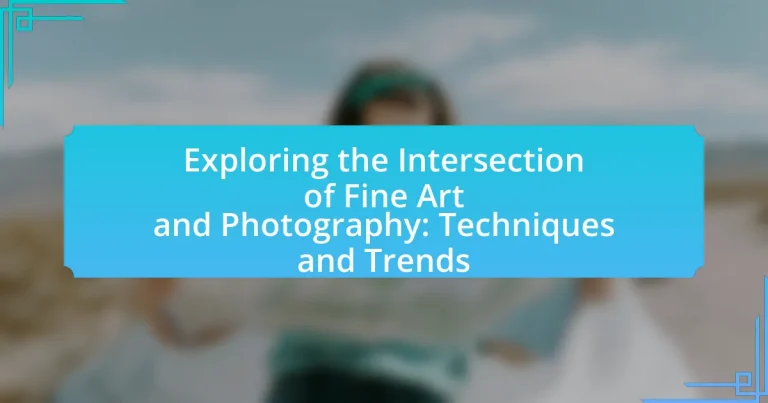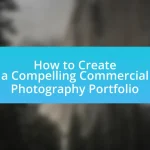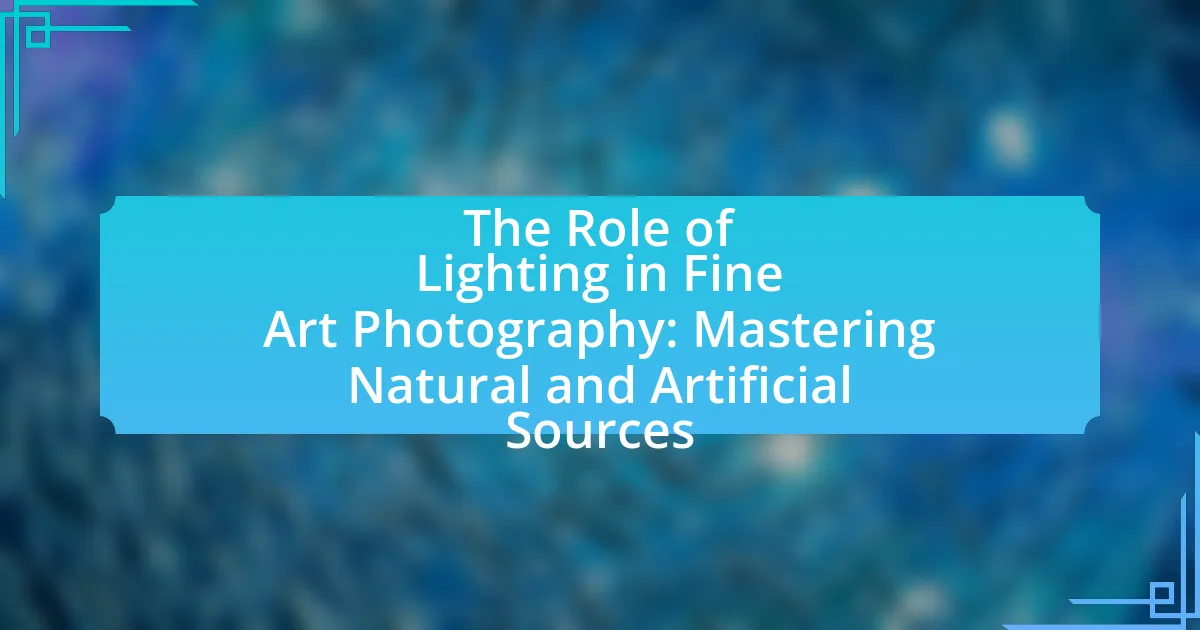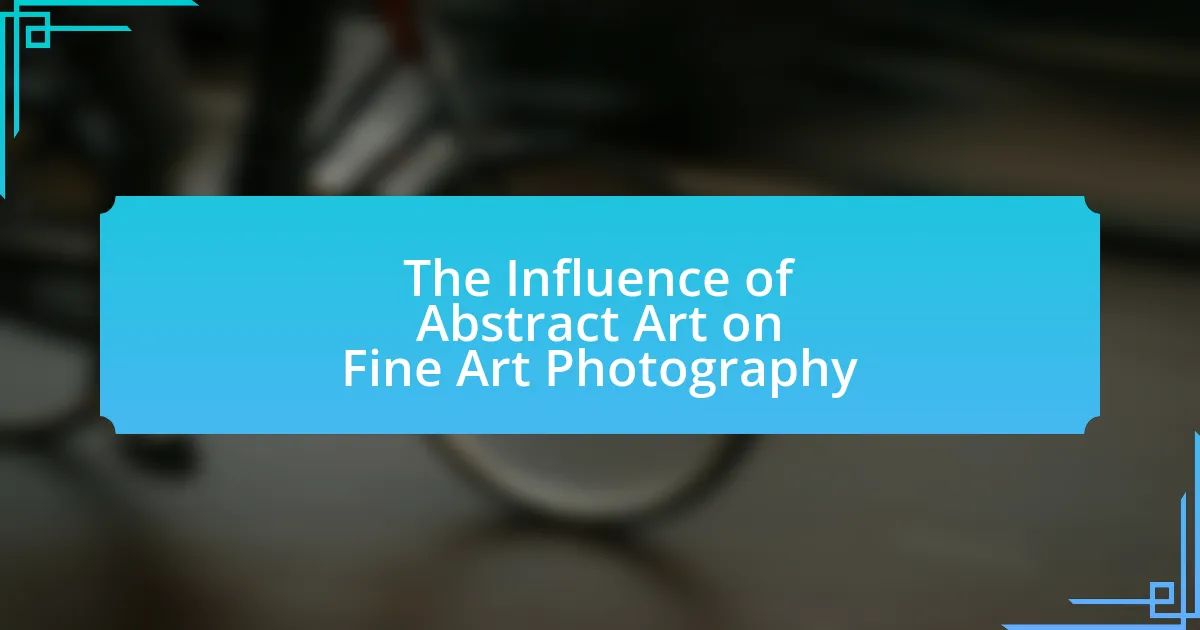The article explores the intersection of fine art and photography, highlighting how photographic techniques are employed to create artistic expressions that convey deeper meanings and emotions. It examines the historical movements that have influenced this blending, such as Pictorialism and Surrealism, and discusses the evolving perception of photography within the fine art community. Key techniques, including digital manipulation and mixed media, are analyzed, along with the role of composition, lighting, and color theory in enhancing fine art photography. Emerging trends, challenges faced by artists, and the impact of fine art photography on contemporary culture and the art market are also addressed, providing a comprehensive overview of this dynamic field.
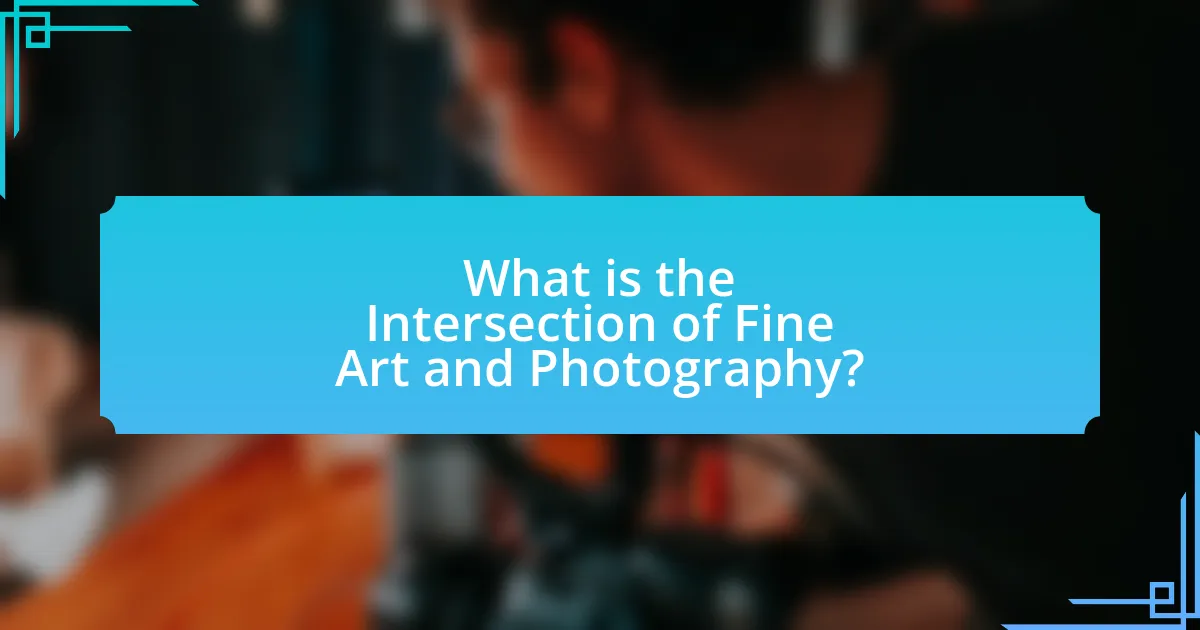
What is the Intersection of Fine Art and Photography?
The intersection of fine art and photography lies in the use of photographic techniques to create artistic expressions that convey deeper meanings and emotions. This relationship has evolved since the 19th century when photography was first recognized as a legitimate art form, allowing artists to explore new dimensions of creativity. Notable movements, such as Pictorialism, emphasized aesthetics and artistic intent in photography, blurring the lines between traditional fine art and photographic practices. Additionally, contemporary artists often utilize photography as a medium to challenge perceptions, explore identity, and comment on societal issues, further solidifying its role within the fine art domain.
How do Fine Art and Photography Complement Each Other?
Fine art and photography complement each other by merging visual storytelling with artistic expression, enhancing the depth and emotional resonance of both mediums. Fine art often serves as inspiration for photographers, who translate artistic concepts into visual narratives through their lens, while photography can capture and immortalize the ephemeral qualities of fine art, such as texture and light. This synergy is evident in movements like Pictorialism, where photographers adopted painterly techniques to elevate photography to an art form, demonstrating that both disciplines can influence and enrich one another.
What historical movements influenced the blending of Fine Art and Photography?
The blending of Fine Art and Photography has been significantly influenced by movements such as Pictorialism, Surrealism, and Modernism. Pictorialism, which emerged in the late 19th century, emphasized artistic expression in photography, encouraging photographers to use soft focus and manipulation techniques to create images that resembled paintings. Surrealism, gaining prominence in the 1920s, further blurred the lines between the two disciplines by incorporating dream-like imagery and unexpected juxtapositions, allowing photographers to explore subconscious themes. Modernism, which followed, embraced new technologies and abstract forms, leading to innovative approaches in both fine art and photography, as artists sought to challenge traditional aesthetics and conventions. These movements collectively contributed to the recognition of photography as a legitimate form of artistic expression, fostering a dynamic interplay between the two fields.
How has the perception of photography evolved within the Fine Art community?
The perception of photography within the Fine Art community has evolved from skepticism to acceptance and recognition as a legitimate art form. Initially, photography was viewed as a mechanical process lacking the creativity associated with traditional art forms like painting and sculpture. However, by the late 20th century, influential movements such as conceptual photography and the rise of artists like Cindy Sherman and Andreas Gursky demonstrated photography’s capacity for artistic expression and commentary. This shift was further solidified by the inclusion of photographic works in prestigious art institutions and exhibitions, such as the Museum of Modern Art’s photography collection, which began in the 1930s. Today, photography is celebrated for its unique ability to capture reality while also serving as a medium for artistic exploration, blurring the lines between documentary and fine art.
What are the Key Techniques Used in Combining Fine Art and Photography?
Key techniques used in combining fine art and photography include digital manipulation, mixed media, and conceptual framing. Digital manipulation allows artists to alter photographs using software, creating surreal or abstract compositions that blend photographic realism with artistic expression. Mixed media involves integrating photographs with traditional art forms, such as painting or collage, enhancing the visual narrative and depth of the artwork. Conceptual framing focuses on the idea behind the image, often using photography as a medium to convey broader themes or messages, thus elevating the photograph to a fine art status. These techniques demonstrate the versatility and creative potential at the intersection of fine art and photography.
What role does composition play in the fusion of these two art forms?
Composition serves as a critical framework in the fusion of fine art and photography, guiding the arrangement of elements to create a cohesive visual narrative. In this intersection, composition influences how viewers perceive and interpret the combined artistic expressions, ensuring that both mediums complement each other effectively. For instance, the principles of balance, contrast, and focal points, commonly utilized in fine art, are equally applicable in photography, enhancing the overall aesthetic and emotional impact of the work. This synergy is evident in contemporary practices where photographers adopt painterly techniques, such as layering and texture, to enrich their compositions, thereby blurring the lines between the two art forms.
How do lighting and color theory impact Fine Art Photography?
Lighting and color theory significantly impact Fine Art Photography by influencing mood, composition, and visual storytelling. Proper lighting can create depth, highlight textures, and evoke emotions, while color theory guides the use of color harmonies and contrasts to enhance the overall aesthetic. For instance, warm colors can evoke feelings of comfort or passion, while cool colors may convey calmness or sadness. Studies show that the interplay of light and color can alter viewer perception, making it essential for photographers to master these elements to effectively communicate their artistic vision.
What Trends are Emerging in Fine Art Photography?
Emerging trends in fine art photography include the integration of digital technology, a focus on sustainability, and the exploration of identity and social issues. Digital technology allows artists to manipulate images in innovative ways, creating new forms of expression. For instance, the use of augmented reality and virtual reality is becoming more prevalent, enabling immersive experiences that engage viewers on multiple levels. Additionally, sustainability is increasingly important, with photographers using eco-friendly materials and practices to address environmental concerns. This trend reflects a broader societal shift towards environmental consciousness. Furthermore, fine art photographers are increasingly addressing themes of identity, race, and gender, using their work to comment on contemporary social issues. This focus is supported by exhibitions and discussions in art circles, highlighting the role of photography in social commentary.
How are contemporary artists redefining the boundaries of Fine Art and Photography?
Contemporary artists are redefining the boundaries of Fine Art and Photography by integrating innovative techniques and concepts that blur the lines between the two disciplines. For instance, artists like Andreas Gursky and Cindy Sherman utilize digital manipulation and staged photography to create works that challenge traditional notions of representation and authenticity in art. This fusion is evidenced by the rise of photo-based installations and mixed media works, where photography serves as a foundational element rather than a standalone medium. Additionally, the use of social media platforms for artistic expression has democratized access to photography, allowing artists to reach wider audiences and engage in dialogues that further expand the definition of Fine Art.
What technological advancements are influencing current trends?
Technological advancements such as artificial intelligence, high-resolution imaging, and digital printing are significantly influencing current trends in fine art and photography. Artificial intelligence is being utilized for image recognition, enhancing creative processes, and generating art, as seen in platforms like DALL-E and DeepArt. High-resolution imaging technology allows artists and photographers to capture intricate details, leading to more immersive experiences in their work. Additionally, advancements in digital printing techniques enable artists to produce high-quality reproductions and mixed media artworks, expanding the possibilities for artistic expression. These technologies are reshaping how art is created, shared, and experienced in contemporary settings.

How Do Artists Approach the Creation of Fine Art Photography?
Artists approach the creation of fine art photography by conceptualizing their vision, selecting appropriate techniques, and utilizing advanced technology to express their artistic intent. They often begin with a clear idea or theme, which guides their choice of subject matter, composition, and lighting. For instance, renowned photographers like Cindy Sherman and Gregory Crewdson meticulously plan their shoots to convey specific narratives or emotions, demonstrating the importance of pre-visualization in fine art photography. Additionally, artists may experiment with various photographic techniques, such as long exposure or digital manipulation, to enhance their creative expression. This approach is supported by the fact that fine art photography has evolved to include diverse styles and methods, reflecting the artists’ unique perspectives and the cultural context in which they work.
What Creative Processes Do Artists Use in This Intersection?
Artists at the intersection of fine art and photography often employ processes such as conceptualization, experimentation, and mixed media techniques. Conceptualization involves developing a clear idea or theme that guides the artwork, often blending visual storytelling with photographic elements. Experimentation is crucial, as artists frequently manipulate photographic techniques—such as exposure, lighting, and digital editing—to create unique visual effects that enhance their artistic vision. Mixed media techniques allow artists to combine traditional fine art methods, like painting or drawing, with photography, resulting in layered and textured works that challenge conventional boundaries. These processes reflect a growing trend where artists seek to redefine the roles of both mediums, as evidenced by the increasing prevalence of photography in contemporary art exhibitions and the rise of artists who identify as both photographers and fine artists.
How do artists conceptualize their work in Fine Art Photography?
Artists conceptualize their work in Fine Art Photography by integrating personal vision, thematic exploration, and technical execution. They often begin with a concept or idea that reflects their emotional or intellectual response to a subject, which can be influenced by cultural, social, or personal narratives. For instance, artists may draw inspiration from historical events, societal issues, or abstract concepts, allowing them to convey deeper meanings through their imagery.
The technical aspects, such as composition, lighting, and post-processing, are then employed to enhance the visual storytelling, ensuring that the final piece resonates with the intended message. This process is supported by the fact that many renowned fine art photographers, like Cindy Sherman and Gregory Crewdson, have utilized specific themes and meticulous staging to provoke thought and evoke emotions in their audience.
What techniques do artists employ to enhance their photographic works?
Artists employ various techniques to enhance their photographic works, including manipulation of lighting, composition, and post-processing. By adjusting lighting, artists can create mood and depth, influencing how the subject is perceived. Composition techniques, such as the rule of thirds or leading lines, guide the viewer’s eye and create visual interest. Post-processing techniques, like color correction and retouching, allow artists to refine their images and achieve a desired aesthetic. These methods are widely recognized in the field, as evidenced by the prevalence of these practices in contemporary photography exhibitions and publications.
What Challenges Do Artists Face in Merging Fine Art and Photography?
Artists face several challenges in merging fine art and photography, primarily related to conceptual integration, technical skills, and audience perception. Conceptually, artists must navigate the differing intentions behind fine art, which often emphasizes expression and interpretation, and photography, which can be seen as a more literal representation of reality. This divergence can create tension in achieving a cohesive artistic vision.
Technically, artists may struggle with mastering both mediums, as fine art techniques like painting or sculpture require different skills compared to photographic processes such as lighting, composition, and digital editing. This duality can lead to a steep learning curve and potential frustration.
Additionally, audience perception poses a challenge; viewers may have preconceived notions about what constitutes fine art versus photography, which can affect the reception of hybrid works. For instance, a study by the National Endowment for the Arts indicates that audiences often categorize art based on traditional definitions, potentially limiting the appreciation of innovative combinations.
These challenges highlight the complexities artists face in successfully merging fine art and photography, requiring them to balance technical proficiency, conceptual clarity, and audience engagement.
How do artists navigate the technical limitations of photography?
Artists navigate the technical limitations of photography by employing creative techniques and alternative methods to enhance their work. They often manipulate exposure settings, utilize various lenses, and experiment with lighting to achieve desired effects that compensate for equipment constraints. For instance, artists may use long exposure times to capture motion or apply filters to alter color balance, thereby expanding the expressive potential of their images. Additionally, many artists embrace post-processing software to refine their photographs, allowing for adjustments that can overcome limitations inherent in the camera’s capabilities. This approach is supported by the fact that digital editing tools have become integral in contemporary photography, enabling artists to push boundaries and explore new visual narratives.
What are the common misconceptions about Fine Art Photography?
Common misconceptions about Fine Art Photography include the belief that it is solely about technical skill or that it requires expensive equipment. Many people think that fine art photography is only about capturing beautiful images without understanding the artistic intent behind them. Additionally, there is a misconception that fine art photography is not accessible to amateur photographers, when in fact, many renowned fine art photographers started as hobbyists. These misconceptions can undermine the appreciation of the medium as a legitimate form of artistic expression, which has been recognized in galleries and museums worldwide.
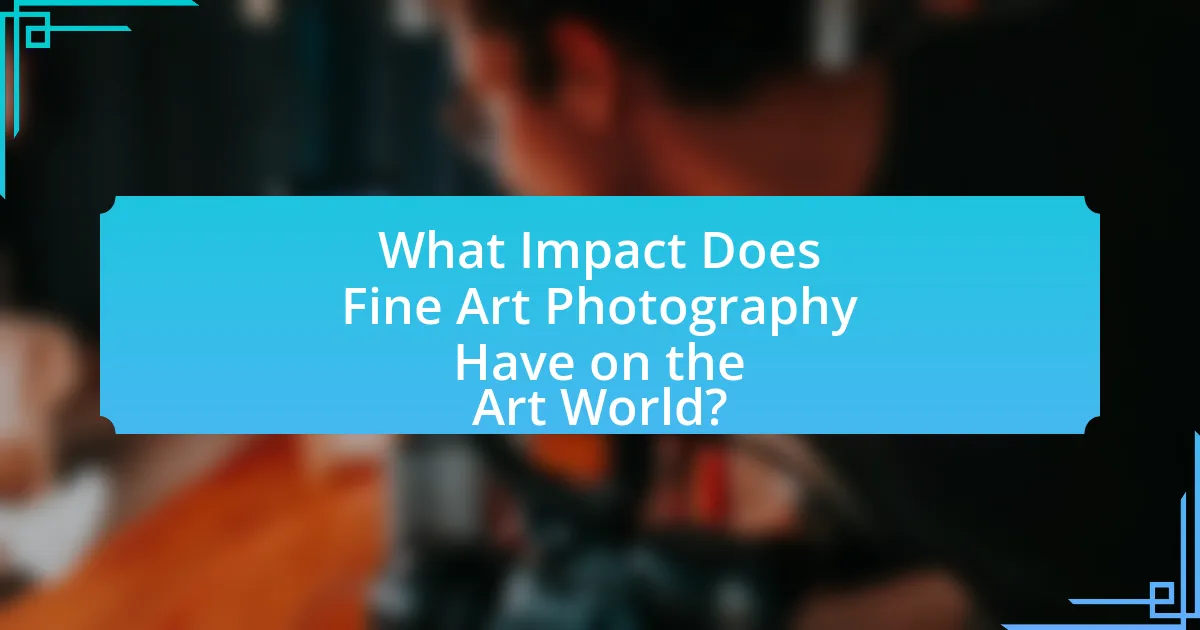
What Impact Does Fine Art Photography Have on the Art World?
Fine art photography significantly influences the art world by expanding the definition of art and challenging traditional boundaries. This medium has gained recognition as a legitimate form of artistic expression, evidenced by the inclusion of fine art photography in major galleries and museums, such as the Museum of Modern Art in New York, which has a dedicated photography collection. Additionally, fine art photography has democratized art creation, allowing more artists to express their vision through accessible technology, leading to a diverse range of styles and perspectives. The rise of photography as fine art has also impacted the market, with high-profile auctions, such as those at Sotheby’s and Christie’s, showcasing fine art photographs that fetch millions, thus validating its economic significance in the art world.
How is Fine Art Photography Received by Critics and Collectors?
Fine art photography is generally received positively by critics and collectors, who recognize its artistic merit and ability to convey complex narratives. Critics often praise fine art photography for its technical skill, emotional depth, and innovative approaches, which can elevate the medium to the same status as traditional forms of fine art like painting and sculpture. Collectors are increasingly investing in fine art photography, as evidenced by auction results; for instance, the sale of a photograph by Andreas Gursky reached $4.3 million at auction in 2011, highlighting the growing market value and appreciation for this art form. This positive reception is further supported by the inclusion of fine art photography in prestigious galleries and museums, which validates its significance in the contemporary art landscape.
What criteria do collectors use to evaluate Fine Art Photography?
Collectors evaluate Fine Art Photography based on criteria such as artistic vision, technical skill, rarity, provenance, and market demand. Artistic vision refers to the photographer’s ability to convey a unique perspective or narrative through their work, while technical skill encompasses the mastery of photographic techniques, including composition, lighting, and post-processing. Rarity is significant as limited editions or unique prints often hold higher value. Provenance, or the history of ownership, adds credibility and can enhance the artwork’s desirability. Lastly, market demand reflects current trends and the collector’s personal taste, influencing the perceived value of the artwork.
How do critics assess the artistic value of photographic works?
Critics assess the artistic value of photographic works by evaluating elements such as composition, technique, emotional impact, and originality. They analyze how effectively a photograph communicates a message or evokes feelings, considering factors like lighting, framing, and subject matter. For instance, the use of innovative techniques, such as long exposure or digital manipulation, can enhance a photograph’s artistic merit. Additionally, critics often reference historical context and the photographer’s intent, comparing the work to established art movements or styles. This multifaceted approach allows critics to provide a nuanced understanding of a photograph’s place within the broader art landscape.
What Role Does Fine Art Photography Play in Contemporary Culture?
Fine art photography serves as a critical medium for artistic expression and cultural commentary in contemporary culture. It allows photographers to explore complex themes such as identity, social issues, and the human experience, often challenging viewers to engage with these topics on a deeper level. For instance, artists like Cindy Sherman and Gregory Crewdson utilize staged photography to critique societal norms and perceptions, thereby influencing public discourse. Additionally, fine art photography has gained prominence in galleries and exhibitions, reflecting its acceptance as a legitimate art form, with sales in the fine art photography market reaching over $1 billion in recent years. This financial growth underscores its significance in both the art world and broader cultural conversations.
How does Fine Art Photography reflect societal issues and trends?
Fine Art Photography reflects societal issues and trends by capturing and interpreting the complexities of contemporary life. This medium often addresses themes such as identity, inequality, and environmental concerns, providing a visual commentary on the state of society. For instance, photographers like Cindy Sherman and Sebastião Salgado have used their work to explore gender roles and social justice, respectively, highlighting how art can provoke thought and inspire change. The incorporation of current events and cultural shifts into photographic narratives serves as a powerful tool for raising awareness and fostering dialogue about pressing societal matters.
What influence does social media have on the visibility of Fine Art Photography?
Social media significantly enhances the visibility of Fine Art Photography by providing a platform for artists to showcase their work to a global audience. Platforms like Instagram and Pinterest allow photographers to share high-quality images, engage with followers, and connect with potential buyers, leading to increased exposure and opportunities for sales. According to a 2021 survey by the Art Market Research, 70% of artists reported that social media was their primary marketing tool, demonstrating its critical role in promoting Fine Art Photography.
What Best Practices Should Artists Follow in Fine Art Photography?
Artists should follow several best practices in fine art photography to enhance their work’s quality and impact. First, they should develop a clear artistic vision, which guides their subject choice, composition, and style. This vision helps create a cohesive body of work that resonates with viewers. Second, mastering technical skills, including camera settings, lighting, and post-processing techniques, is essential for achieving the desired aesthetic. For instance, understanding the exposure triangle (aperture, shutter speed, and ISO) allows artists to manipulate light effectively.
Additionally, artists should focus on composition principles such as the rule of thirds, leading lines, and framing to create visually compelling images. Engaging with the art community through critiques and exhibitions can provide valuable feedback and exposure. Finally, maintaining a consistent practice and experimenting with different techniques fosters growth and innovation in their artistic journey. These practices are supported by the fact that artists who engage in continuous learning and community interaction often produce more impactful and recognized work in the fine art photography field.
How can artists effectively market their Fine Art Photography?
Artists can effectively market their Fine Art Photography by leveraging online platforms, social media, and targeted exhibitions. Utilizing websites and social media channels like Instagram and Pinterest allows artists to showcase their work to a global audience, increasing visibility and engagement. According to a 2021 survey by Artfinder, 70% of artists reported that social media significantly boosted their sales. Additionally, participating in local and international art fairs or exhibitions can create networking opportunities and attract potential buyers. Research indicates that artists who engage in both online marketing and physical exhibitions see a 50% increase in sales compared to those who rely on one method alone.
What tips can enhance the artistic quality of Fine Art Photography?
To enhance the artistic quality of Fine Art Photography, photographers should focus on composition, lighting, and subject matter. Effective composition involves using techniques such as the rule of thirds, leading lines, and framing to create visually engaging images. Proper lighting, whether natural or artificial, can dramatically affect the mood and depth of a photograph, emphasizing textures and colors. Additionally, selecting compelling subject matter that evokes emotion or tells a story can elevate the artistic impact of the work. These strategies are supported by the principles of visual art, which emphasize the importance of arrangement, illumination, and thematic relevance in creating impactful imagery.












